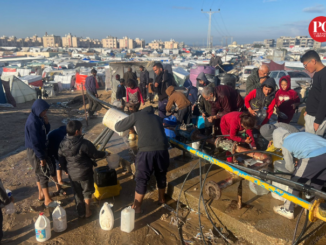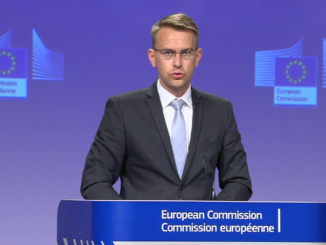
By Benay Blend
Calling for Palestinians to decide their future is the only suitable form of peace with justice, with an emphasis on the latter to ensure that the former is sustainable and self-determined.
In 2019, Within Our Lifetime (WOL), a Palestinian-led community organization that has been building the movement for Palestine since 2015, participated in nine weeks of sustained action against the Whitney Museum aimed at removing Board Member Warren Kanders, CEO of Safariland, manufacturer of tear gas used against migrant families at the Mexico/US border, water protectors at Standing Rock, Black protestors in Ferguson, and Palestinians during the Great Return March and beyond.
Moreover, the New York Police Department (NYPD) purchased $7.3 million of weapons and gear from Safariland in 2016 to use against people of color in New York.
Along with Decolonize This Place and other community members, WOL’s actions brought about the resignation of Kanders from the board. At that time, WOL Chair Nerdeen Kiswani explained their case: “If you take peace from the people, we take peace from you.”
Not only did WOL fulfill the “justice” part of their mission, it also drew connections between the US role in Israel’s ethnic cleansing of Palestine and the way that aggression comes home against people of color residents of New York.
More recently, WOL took on the Brooklyn Museum for its complicity in the Gaza genocide. On May 31— “the 237th day of the ongoing genocide in Gaza in which over 40,000 Palestinians have been massacred by the zionist entity”—thousands of community members entered the museum while many more followed the lead of WOL which led a march to the museum’s gate. Others who took to the roof unfurled a banner which carried the action’s demand: “Free Palestine: Divest from Genocide.
Despite its claim to be a “progressive” institution, based on its willingness to allow Black Lives Matter activists to use its facilities during the protests, behind the scenes it remains invested in the “ongoing colonization, ethnic cleansing and genocide of the Palestinian people.”
WOL’s campaign was built on a statement issued by museum workers several months prior to the protest. In it they explained that “in the United States, cultural institutions have largely uplifted a narrative of recent events that erases or downplays Palestinian loss, discredits the Palestinian fight for self-determination, and dehumanizes Palestinians.”
While cultural institutions often highlight justice movements of the past, the statement read, these same establishments fail to lift up those in the present. In this way, they contribute to “eras[ing] or downplay[ing] Palestinian loss, discredit[ing] the Palestinian fight for self-determination, and dehumanize[ing] Palestinians.”
Like Sophie Scholl, the German student who was executed for refusing to be silent about Germany’s actions during World War II, museum workers, along with WOL and other pro-Palestinian organizations, staged a demonstration protesting the museum’s complicity through donors invested in the Gaza genocide.
On that Friday in December museum directors called NYPD who arrived promptly to brutalize and arrest participants. Undaunted, activists within WOL vowed to return, bigger and stronger the next time.
On June 12, in response to the museum’s failure to condemn the Gaza genocide and to disclose and divest from “Israel’s” war on Gaza, activists smeared red paint and graffiti on the homes of four executives from the Brooklyn Museum.
At the home of Anne Pasternak, the director of the Brooklyn Museum and the only Jewish exec among the four, a banner was dropped with the words “white supremacist Zionist” between two pillars outside her front door.
Predictably, NYC public officials, along with the mainstream press, attributed the event to anti-Semitism, while ignoring the context of complicity in the Gaza genocide. For example, Mayor Eric Adams tweeted: “This is not peaceful protest or free speech. This is a crime, and it’s overt, unacceptable antisemitism.” In this way, Adams equates Zionism, an ideological movement, with Judaism, a religious movement, as if they were the same.
The South Florida Sun-Sentinel focused on the image of the inverted red triangle also sprayed on Pasternak’s home. It conceded that it was “seen by some as a symbol of Palestinian resistance,” but went on to say that it actually represents the “terror” group Hamas, thereby neglecting to put Oct. 7th in the context of 76 years of brutal “Israeli” occupation.
Kiswani’s words put direct action into context: “If you take peace from the people, we take peace from you.” WOL’s campaign brought the siege home to people who might otherwise ignore it. Graffiti is never a violent act; only in a capitalist country which puts property rights over human life would it seem so.
In “Priority of the Oppressed: Let the Small Red Triangle Guide You,” journalist Ramzy Baround explains that the red triangle has been used in photos to guide readers to where they “should be looking”—at mass graves filled with Palestinians; at mutilated bodies of dead children in hospital morgues, in the streets, and sometimes held for the last time in their parent’s arms.
For protesters around the world, Baroud concludes, “this symbol not only represented more than Palestinian Resistance in Gaza, but the need for action everywhere else,” exactly what WOL and others have been doing, even though it makes some uncomfortable because it shifts the focus away from the false narrative of “Israel” as victim and reconstructs it as it should be, on the entity as ongoing victimizer of Palestinians.
The demand for peace with justice cuts through the obstacles in the way of Palestinian liberation and return. Although there have been many ceasefire resolutions, from city councils to major labor unions, as well as calls from Australia, Canada, and New Zealand for a “humanitarian ceasefire,” Hamas has said that any agreement must include a permanent withdrawal from Gaza by Zionist troops along with a permanent ceasefire, both items that the US and “Israel” are not likely to respect.
In a similar vein, James Dennis Hoff notes that nonprofit groups and political organizations such as Our Revolution, along with Democratic Party politicians, have organized a “vote uncommitted” campaign to push the president to commit to a cease-fire.
“But this campaign,” Hoff writes, “which offers little more than an abstract criticism of the president’s support for Israel, does not specify what a cease-fire should look like and thus creates an opening for Biden’s rehabilitation.” Indeed, it has become increasing clear, he continues, that the Democratic Party and its supporters “are hoping to use the ‘vote uncommitted’ campaign and the broader demand for a cease-fire to drive people back to the Democratic Party.”
Though a temporary ceasefire would give the Palestinians some respite in the short term, in the long run, as Hoff explains, “a six week cease-fire is quite obviously insufficient.”
In order to achieve more than a ceasefire, he suggests using “working-class methods of struggle.” Direct action, such as blockades of weapons shipments; forcing labor to stand with grassroots movements rather than the Democratic Party; and using the strike weapon in work places—all of these actions are outside of and more effective than the ballot box.
Finally, Hoff concludes where this article began; “ultimately, we must be clear that any cease-fire is insufficient if it does not include the immediate and permanent withdrawal of all Israeli troops and an end to the siege on Gaza.” In the end, this means for Hoff “a military defeat of Israel as an appendage of U.S. imperialism in the Middle East,” and the creation of a “single socialist state.”
However noble, this seems like another form of imperialism, imposing an outside solution onto another group of people. In the long run, calling for Palestinians to decide their future is the only suitable form of peace with justice, with an emphasis on the latter to ensure that the former is sustainable and self-determined.

– Benay Blend earned her doctorate in American Studies from the University of New Mexico. Her scholarly works include Douglas Vakoch and Sam Mickey, Eds. (2017), “’Neither Homeland Nor Exile are Words’: ‘Situated Knowledge’ in the Works of Palestinian and Native American Writers”. She contributed this article to The Palestine Chronicle.







